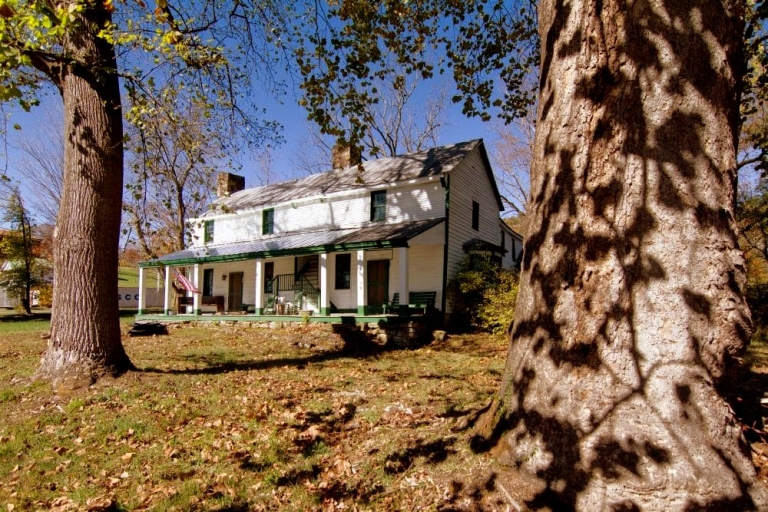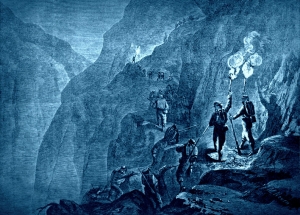
A team of horses races across winding mountain roads, urged onward by the crack of a stage driver’s whip. Inside the coach, six weary passengers started their two-day journey at 1 p.m. that afternoon. They are tired and hungry and are eagerly awaiting their next stop, where they can disembark, stretch their legs, get some hot food and settle into a soft bed for the night at the “Halfway House” Tavern.
It sounds like a scene reminiscent of the Old West, but in this case, the stage route runs along the old James River and Kanawha Turnpike, the passengers are traveling from Lewisburg to Charleston, and the “Halfway House” is located in Mountain Cove, now the town of Ansted, in Fayette County, West Virginia.
From 1827 to 1861, when the Civil War brought a halt to commercial traffic along the route, the Porter and Belden stage line operated coaches that carried passengers and mail along the old turnpike road (now known as the Midland Trail or U.S. 60), first between Lewisburg and Charleston, then later to Guyandotte (now East Huntington), and still later as far as Kenova in Cabell County.
The stage runs originally were once a week both ways, then twice, then three days, and finally, in the 1850s, daily. Relay stations, where drivers changed horses and allowed the passengers a few moments to “stretch their legs,” were located every 10 miles along the route. A few of these stations also served as overnight stops (the stages did not run between sundown and sunup), and the “Halfway House” was one of them.
Owned by William Tyree, a sheriff of Fayette County, from 1834 until his death in 1883, the two-story house still stands along the old route that runs through the town of Ansted, just across from the U.S. Post Office. Over the years it has served as both a private residence and a bed-and-breakfast facility.

In 1978 it was added to the National Register of Historic Places, and the W.Va. Department of Culture and History erected a historical marker in front of it. Because it was also used as a headquarters by both Union and Confederate generals during the Civil War—and served in 1862 as quarters for a regiment from Illinois nicknamed “The Chicago Dragoons”—a Civil War Trails marker has also been placed in front of the house.
The current owners of the house put it on the market earlier this year, but the $200,000 asking price may have proved a bit steep for some prospective buyers—along with the fact that the structure, built more than 200 years ago, requires some upgrading and maintenance.
But David Sibray of Foxfire Realty, who is working with the owners on the sale, says the need for renovations shouldn’t scare anyone away because its listing on the National Register of Historic Places makes it “eligible for grants and tax credits, many of which are available to rectify any problems.”
The “Halfway House” is also located close to Hawks Nest State Park, the Hawks Nest Overlook, and the New River Gorge Bridge, and the New River Gorge National Park. Sibray says this makes it ideal as a bed-and-breakfast or a museum. “The house is incredible,” he says. “It’s unlike anything you normally find by way of a house.”
According to information compiled by a researcher with the West Virginia Department of Culture and History to support the house’s nomination to the National Register in 1978, the original house—a log cabin with two outside chimneys on either side—was most likely built sometime between 1800 and 1810 by Joseph Skaggs, who inherited a 400-acre tract of land that his father had bought in 1792.
In 1827, Joseph Skaggs sold the house to George Hunter, who served as the first postmaster of the area known as Mountain Cove. Hunter may have made the first additions to the house—such as adding rooms to the east side of the house and then enclosing the entire structure with clapboard—in order to operate it as a post office and stage stop after the stage line was established in 1827.
When Tyree bought the house in 1834, the post office moved to several other locations until it finally returned to the tavern after Hunter’s death in 1859. Tyree is thought to have expanded the house again to include additional back rooms and a unique flight of outside steps on the front porch leading to the upstairs level.
Jim Costa, an architectural historian, agrees that the house began as a smaller log cabin to which rooms were added and that both sections were then enclosed with clapboard to give it the appearance of a unified house. But he also thinks the outside stairway could have been the original stairway of the house and not added later.
“I’ve seen houses from the 1790s that have an outside stairway like that, so it’s possible that is the original one,” Costa said. “But determining what is the oldest part of the house and when the rest was added is very difficult without doing some more research into the type of wood and nails that were used, and how the wood was cut.”
Aside from the house’s age, its use as a stage stop is historic in itself. Many famous personalities of the 19th century stayed overnight in one of the six bedrooms on the upstairs floor of the house—Henry Clay, Daniel Webster, John Breckinridge, and possibly Stonewall Jackson (whose mother is buried in nearby Westlake Cemetery).
Sibray is hoping that a possible public auction of the house sometime early in 2021 will generate more interest in the house. For more information, contact him at Foxfire Realty.




























